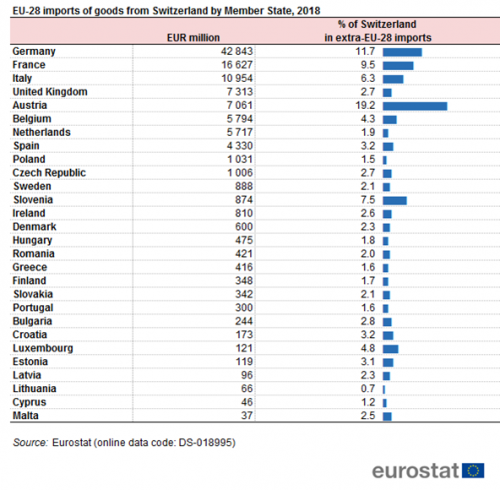Archive:Switzerland-EU - international trade in goods statistics
Data extracted in April 2018
Planned article update: April 2019
Highlights
In 2016, Switzerland was the 10th largest exporter of goods in the world with a share of 2.5 % of world exports and the 12th largest importer with a share of 2.1 % of world imports.
Imports, exports and trade balance between the EU and Switzerland, 2007-2016
This article provides a picture of the international trade in goods between the European Union (EU) and Switzerland. It analyses the type of goods exchanged between the two economies and the shares of each EU Member State in those exchanges. This article is part of an online publication providing recent statistics on international trade in goods, covering information on the EU's main partners, main products traded, specific characteristics of trade as well as background information.
Full article
Overview
- In 2016, Switzerland was the 10th largest exporter of goods in the world with a share of 2.5 % of world exports and the 12th largest importer with a share of 2.1 % of world imports.
- In 2017, among EU's trading partners, Switzerland was the third largest origin for EU imports and the fourth largest destination for EU exports.
- The EU trade balance with Switzerland was in surplus from 2007 to 2017 and peaked at EUR 75 billion in 2013. From 2016 to 2017 it doubled from EUR 20 billion to EUR 41 billion.
- In 2017, manufactured goods dominated both the exports of goods from the EU to Switzerland and imports from Switzerland to the EU, accounting for over 78 % of the total exports and 83 % of total imports.
- In 2017, among EU Member States, Germany was the largest importer (EUR 43 billion) from Switzerland and the largest exporter (EUR 54 billion) to Switzerland.
- Germany had the largest trade surplus with Switzerland (EUR 11 billion), while France had the largest trade deficit with Switzerland (EUR 0.9 billion).
EU and Switzerland in world trade in goods
Figure 1a shows that the four largest exporters account for half of the world exports. The largest is China (17 %) followed by the EU (16 %), the United States (12 %) and Japan (5 %). The same four also account for half of the world imports though in a different order. Here the USA (18 %) leads, followed by the EU (15 %), China (12 %) and Japan (5 %).

Source: Eurostat (ext_lt_introle)
Figure 1b has some more detail, showing the twenty-five largest exporters and importers in the world. Switzerland is the tenth largest exporter (EUR 275 billion), accounting for 2.5 % of world exports, situated between Singapore (2.7 %, EUR 298 billion) and the United Arab Emirates (2.4 %, EUR 270 billion). Switzerland is the twelfth largest importer (EUR 243 billion) accounting for 2.1 % for world imports, situated between the United Arab Emirates (2.1 %, EUR 245 billion) and Taiwan (1.8 %, EUR 209 billion).
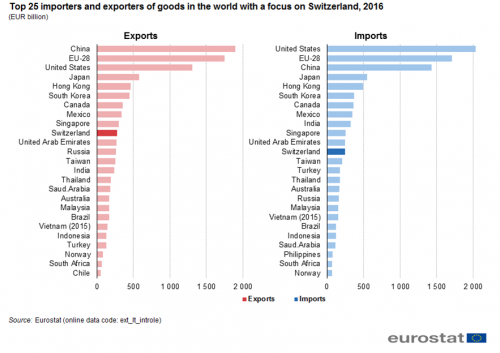
Source: Eurostat (ext_lt_introle)
Figure 2 shows changes in trade between the EU and Switzerland from 2007 to 2016. From 2007 to 2011, the exports and imports (both indexed at 100 % in 2007) of both economies grew similarly. Between 2011 and 2013, Swiss exports and imports rose faster than the EU’s. Swiss exports and imports fell in 2014, rising again in 2015 and 2016. In 2016, the exports index peaked at 119 percentage points (pp) over its 2007 level, with the imports index up 107 pp.
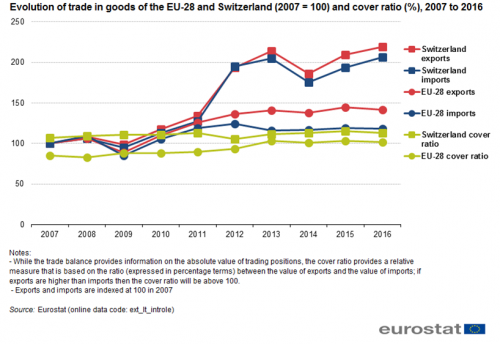
Source: Eurostat (ext_lt_introle)
Switzerland is the EU's largest European partner for trade in goods
Figure 3 shows that in 2017, Switzerland had a share of 8 % in extra-EU exports (EUR 151 billion) and 6 % in extra-EU imports (EUR 110 billion). This meant that it was the EU's third largest partner for exports, behind the United States (EUR 376 billion) and China (EUR 198 billion) and followed by Russia (EUR 86 billion). In imports it was the fourth largest partner, behind the United States and China and Russia. In total trade (exports plus imports) Switzerland with EUR 261 billion was the largest European partner of the EU ahead of Russia (EUR 231 billion).

Source: Eurostat (ext_lt_maineu)
EU imports from Switzerland have been growing steadily since 2007 and were not much effected by the financial crisis (see Figure 4). They fell somewhat between 2012 and 2013 but recovered since then, reaching EUR 122 billion in 2016 before dropping to EUR 110 billion in 2017.
Exports from the EU grew more than imports in the same period and also fluctuated more, with decreases in 2009, 2012, 2014 and 2016. They peaked in 2013 at almost EUR 170 billion, dropped to EUR 142 billion in 2016 but grew to EUR 151 billion in 2017. The trade surplus also peaked in 2013 at 75 billion, dropping to 20 billion in 2016 before doubling in 2017 to EUR 40 billion.
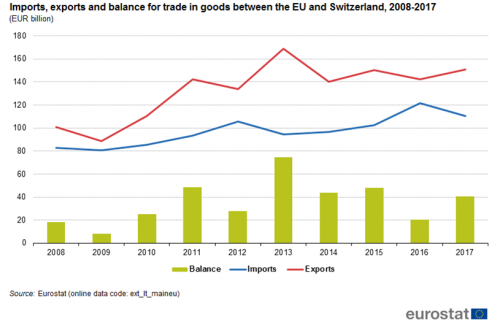
Source: Eurostat (ext_lt_maineu)
Manufactured goods dominate trade with Switzerland
When breaking down imports and exports by SITC groups, the main categories of exports to and imports from Switzerland are 'Machinery and vehicles' (SITC 7), 'Chemicals' (SITC 5) and 'Other manufactured goods' (SITC 6&8). Together these manufactured goods accounted for around 78 % of the EU exports and 83 % of imports in 2017 (see Figure 5). In exports 'Other manufactured goods' were the largest group with 31 % while in imports 'Chemicals' accounted for 37 % of the total.
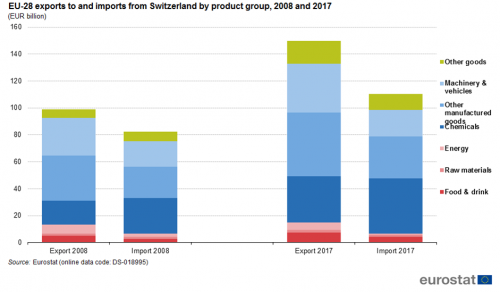
Source: Eurostat DS-018995
Figure 6 shows the evolution of EU imports and exports by SITC group since 2008. In 2017 the EU had a large trade deficit in 'Chemicals' (EUR 7 billion). In all the other groups the EU had a surplus, which was largest in in 'Machinery and vehicles' (EUR 15 billion) closely followed by 'Other manufactured goods' (EUR 14 billion).

Source: Eurostat DS-018995
Most traded goods: non-monetary gold and medicaments
Figure 7 gives more details about the goods exchanged between the EU and Switzerland, showing the top 20 traded goods at a more detailed level (by SITC level 3). Those top 20 goods covered 56 % of total traded goods in 2017. Ten products among the top 20 belong to 'Other manufactured goods', four to 'Machinery and vehicles', three to 'Chemicals', two to 'Other goods' and one to 'Energy'. The first and third most traded products were medical products products, while non-monetary gold came second.
Another interesting way to look at data is to investigate the export/import ratio of traded goods, in order to better identify the direction taken by flows and specialisation between the two areas. These ratios can be found in the right margin of Figure 7. The top two products, 'medicaments' and 'non-monetary gold', have ratios above 100 indicating higher exports than imports. The reverse is true for the next two products, 'medicinal and pharmaceutical products' and 'organo-inorganic and related compounds'. The highest cover ratios among the top 20 products were found for 'motor cars and motor vehicles' and 'petroleum oils other than crude' while the lowest was found for 'watches and clocks'.
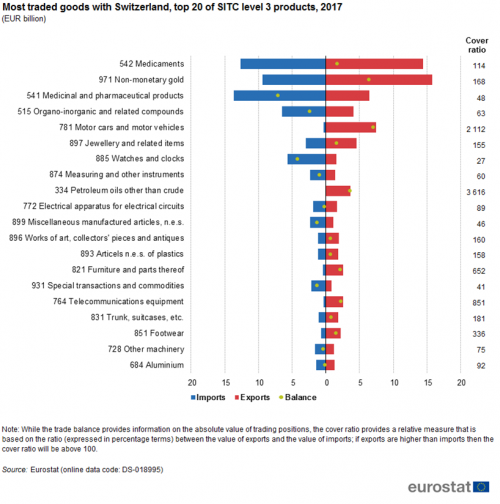
Source: Eurostat DS-018995
Germany is trading most with Switzerland
Table 8a shows Member States' imports from Switzerland and the share of Switzerland in national extra-EU imports. Table 8b provides similar information but concerning Member States' exports to Switzerland.
There are four Member States whose imports from Switzerland in 2017 were higher than EUR 10 billion: the Germany (EUR 43 billion), France (EUR 17 billion), the United Kingdom (EUR 12 billion) and Italy (EUR 11 billion). Together they accounted for 75 % of imports from Switzerland. Three countries had more than 10 % of their imports originating from Switzerland namely Austria (22 %), Germany (12 %) and France (10 %)
The four largest importers from Switzerland were also the largest exporters to Switzerland in 2017. Again Germany (EUR 54 billion) was the largest, followed at some distance by Italy (EUR 21 billion), the United Kingdom (EUR 18 billion) and France (EUR 16 billion). Their combined share in total EU exports to Switzerland was 72 %. Six Member States exported at least 10 % of their total extra-EU exports to Switzerland. These were Austria (17 %), Luxembourg (15 %), Ireland and Slovakia (both 11 %), Italy and Germany (both 10 %).
Table 8c shows that 10 Member States had a trade deficit with Switzerland in 2017, ranging from just EUR 5 million for Cyprus to EUR 947 million for France. Germany (EUR 11 billion), had the largest trade surplus while Italy (EUR 9 billion), the United Kingdom and Ireland (both EUR 6 billion) also had trade surpluses of more than EUR 5 billion.
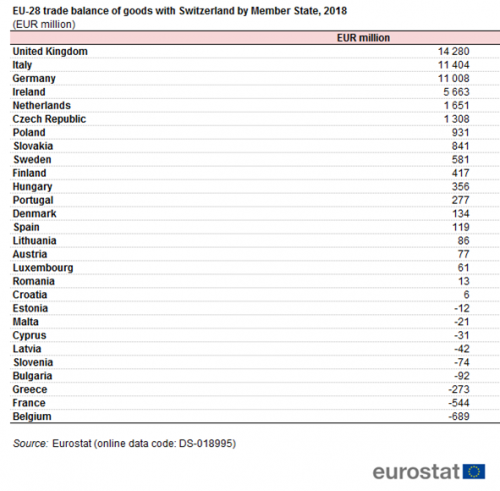
Source: Eurostat DS-018995
Source data for tables and graphs
Data sources
EU data is taken from Eurostat's COMEXT database. COMEXT is the reference database for international trade in goods. It provides access not only to both recent and historical data from the EU Member States but also to statistics of a significant number of third countries. International trade aggregated and detailed statistics disseminated via the Eurostat website are compiled from COMEXT data according to a monthly process.
Data are collected by the competent national authorities of the Member States and compiled according to a harmonised methodology established by EU regulations before transmission to Eurostat. For extra-EU trade, the statistical information is mainly provided by the traders on the basis of customs declarations.
EU data are compiled according to Community guidelines and may, therefore, differ from national data published by the Member States. Statistics on extra-EU trade are calculated as the sum of trade of each of the 28 EU Member States with countries outside the EU. In other words, the EU is considered as a single trading entity and trade flows are measured into and out of the area, but not within it.
Data for the other major traders are taken from the Comtrade database of the United Nations. Data availability differs among countries, therefore Figure 1 shows the latest common available year for all the main traders. For the calculation of shares the world trade is defined as the sum of EU trade with non-EU countries (source: Eurostat) plus the international trade of non-EU countries (source: IMF Dots database).
Methodology
According to the EU concepts and definitions, extra-EU trade statistics (trade between EU Member States and non-EU countries) do not record exchanges involving goods in transit, placed in a customs warehouse or given temporary admission (for trade fairs, temporary exhibitions, tests, etc.). This is known as ‘special trade’. The partner is the country of final destination of the goods for exports and the country of origin for imports.
Product classification
Information on commodities exported and imported is presented according to the Standard international trade classification (SITC). A full description is available from Eurostat’s classification server RAMON.
Unit of measure
Trade values are expressed in millions or billions (109) of euros. They correspond to the statistical value, i.e. to the amount which would be invoiced in the event of sale or purchase at the national border of the reporting country. It is called a FOB value (free on board) for exports and a CIF value (cost, insurance, freight) for imports.
Context
Trade is an important indicator of Europe’s prosperity and place in the world. The bloc is deeply integrated into global markets both for the products it sources and the exports it sells. The EU trade policy is an important element of the external dimension of the ‘Europe 2020 strategy for smart, sustainable and inclusive growth’ and is one of the main pillars of the EU’s relations with the rest of the world.
Because the 28 EU Member States share a single market and a single external border, they also have a single trade policy. EU Member States speak and negotiate collectively, both in the World Trade Organization, where the rules of international trade are agreed and enforced, and with individual trading partners. This common policy enables them to speak with one voice in trade negotiations, maximising their impact in such negotiations. This is even more important in a globalised world in which economies tend to cluster together in regional groups.
The openness of the EU’s trade regime has meant that the EU is the biggest player on the global trading scene and remains a good region to do business with. Thanks to the ease of modern transport and communications, it is now easier to produce, buy and sell goods around the world which gives European companies of every size the potential to trade outside Europe.
Direct access to
- International trade in goods (t_ext_go), see:
- International trade in goods - long-term indicators (t_ext_go_lti)
- International trade in goods - short-term indicators (t_ext_go_sti)
- International trade in goods (ext_go), see:
- International trade in goods - aggregated data (ext_go_agg)
- International trade in goods - long-term indicators (ext_go_lti)
- International trade in goods - short-term indicators (ext_go_sti)
- International trade in goods - detailed data (detail)
- EU trade since 1988 by SITC (DS-018995)
- International trade in goods statistics - background
- International trade in goods (ESMS metadata file — ext_go_esms)
- User guide on European statistics on international trade in goods
